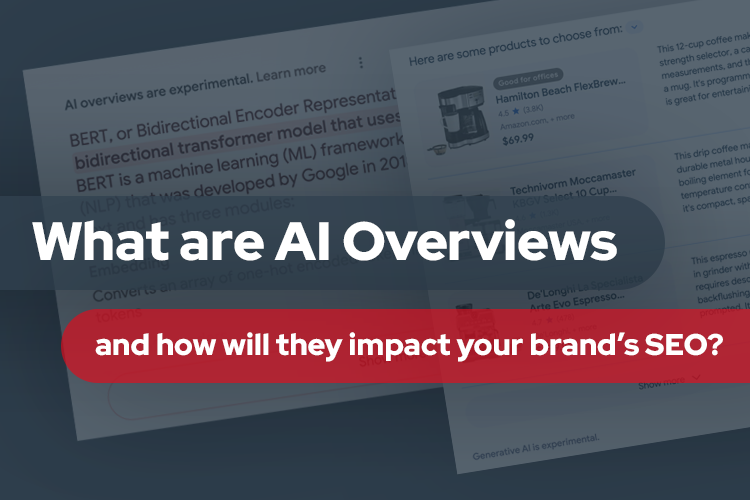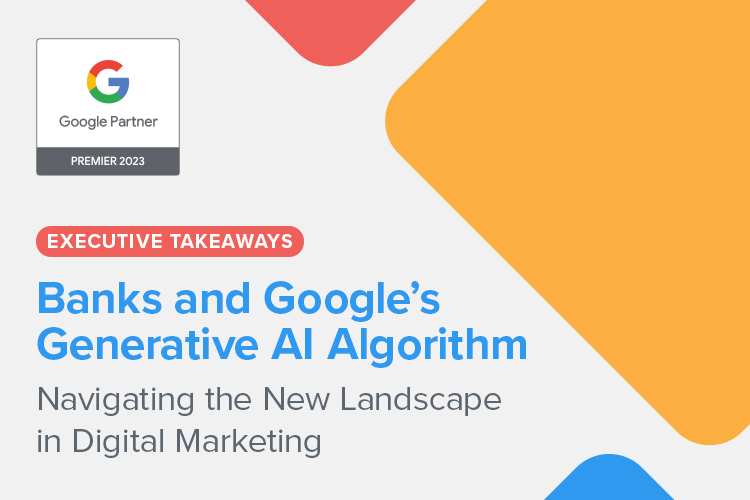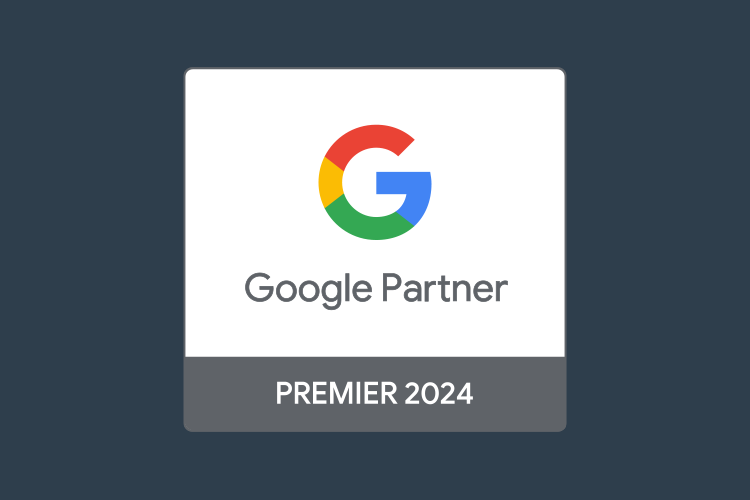
Google’s AI Overviews, formerly known as Search Generative Experience (SGE), are fundamentally changing the way users discover information, products and brands. Since its nationwide rollout three weeks ago, Google’s AI Overview product has been popping up in a large portion of searches, looking to provide users with instant information and produce zero-click searches. This can mean large changes (both positive and negative) in a website’s search impressions, clicks and brand visibility.
Businesses need to understand how AI Overviews, formerly known as SGE, work and how they can capitalize on it to prevent a collapse in organic website traffic. Now is the time to seriously evaluate your website’s SEO tactics. Here are the four things we’ll discuss in this blog:
- What is an AI Overview? How does it work?
- What do AI Overviews actually do?
- How can AI Overviews affect your brand?
- What SEO tactics can increase your brand visibility in the age of AI Overviews?
Looking for the TL/DR? Here are five takeaways.
What is an AI Overview? How does it work?
Google’s AI Overviews feature is an AI-powered search result. Google uses its flagship Gemini AI product along with its PageRank algorithm to provide a curated response to the user. Fundamentally, AI Overviews are a Large Language Model (LLM), a computer architecture that ingests billions of gigabytes of information to understand, predict and produce responses to natural language prompts.
While LLMs like AI Overviews, search generative experiences, and ChatGPT can produce excellent information and simplify complex subjects, they also have their limitations. LLMs can only work well if they have good information. Since they predict answers, they can sometimes give wrong or half-true answers. They don’t really think or understand like humans do. They just use math to guess, and sometimes those guesses are wrong, funny or even dangerous. There are a number of examples of this from the first few weeks of Google’s AI Overviews rollout.
What do AI Overviews actually do?
Generally, Google recognizes four types of search queries: informational, transactional, commercial and navigational. An AI Overview can present itself in a few different ways depending on the type of search.
1. AI Snapshot
AI Snapshot provides a quick summary answer to your search query. This summary is usually pulled or conglomerated from top-ranking search results. Factors such as authority, content freshness and popularity play into which results Google selects as its AI Overview sources. Source pages are then displayed under the AI Snapshot.
2. Conversational Mode
Conversational Mode answers follow-up questions in a conversational style. In some searches, this will show under the AI Snapshot after the user clicks “show more.” For other searches, it won’t show at all.
3. Product Listings
Product Listings provide a list of features, details and reviews in commercial or transactional searches. They include a link to the product page to allow users to make a purchase.
How can AI Overviews affect your brand?
The biggest shift in the history of Google Search doesn’t come without significant impacts for brands. Some brands will thrive online due to AI-powered searches. Others will see dramatic decreases in their organic search traffic. Here are two possible outcomes for your website:
1. A decrease in organic website traffic.
It is quite likely that your website will see a decrease in organic website traffic, especially if you have a significant portion of traffic coming from non-branded searches. These non-branded queries are most likely to produce AI Overview results and zero-click searches. With the information available right on the SERP, users won’t have as much of a need to click through to a website to find their answer. And this is assuming your website appears in the AI Overview result.
If your site doesn’t appear – good luck! Google just pushed your website even further down the SERP, decreasing both your visibility and click-through rate.
2. An increase in organic search visibility & brand authority.
The positive side of AI Overviews and search generative experiences? Increased visibility for those websites lucky (or high quality) enough to be chosen. On every AI Snapshot or Product Listing Google sources from your site, they’ll place your link above the fold. Even if this placement doesn’t result in more website clicks, it puts more eyeballs on your brand and recognizes your authority as a subject-matter expert for the search query.
What SEO tactics can help increase your brand’s visibility in AI Overviews?
So how can brands win in an AI-dominated search landscape? Really, a lot of old-school SEO tactics are still important. In their AI Overview search results, Google is still prioritizing quality, helpful content. How the game changes, however, is the consequence of not having good content.
Websites that don’t show up in an AI Overview – whether it is because their content is not digestible by the search engine or it’s not up to scratch in quality – will pay the price for their poor SEO practices more than they did in the past. This applies to businesses of all types. Whether you’re a major media publisher, run the website of a medium-sized regional business or run a local plumbing company, bad SEO will result in fewer site visitors and fewer customers, now more than ever.
Here are five tips for how to increase your brand’s visibility in the early days of AI Overviews, formerly known as SGE.
1. Prioritize crawlability, indexability & technical SEO.
The first step in any SEO process is the most straightforward: make sure that your content is crawlable and indexable. Inspect your page in Google Search Console and ensure that robots.txt, a faulty sitemap, bad internal linking or canonical tags are not keeping Google from indexing the page.
On top of those basics, following Google’s technical SEO best practices on things like meta data, header tags, schema and page performance are more important than ever to make sure your business shows up in AI-powered search results.
2. Develop your brand equity and own branded searches.
With only a few exceptions, branded searches are going to be the leading driver of organic traffic to your website. How does your brand then receive more searches? By increasing your overall brand equity. Through the success of other marketing activities like public relations or awareness advertising, more people search for your brand.
This increase in branded searches and subsequent organic search traffic will help you rank in non-branded queries as well. Traffic is a ranking signal for Google. There’s a reason large sites and brands dominate certain categories in SERP.
3. Focus on local search.
Google has been prioritizing localized results for well over a decade now, but having a robust, active and accurate Google Business Profile (GBP) is paramount. A local plumber might not show up in the AI Overviews result for the query “fixing a leaky sink.” However, he can and should show up when the user decides the process is too complicated and needs to search for a “plumber near me.”
It’s imperative that a company has an active GBP account with images, FAQs, events, accurate company info, rating and review solicitation and management. The GBP is not an afterthought – it needs to be front and center in any good SEO strategy.
4. Write original, useful and engaging content.
As always, Google is looking for helpful content that answers users’ questions. Having expert, authoritative and trustworthy content brings it to the forefront of Google’s mind. Sharing content in multiple formats – text, image, video and audio – helps as well. Ultimately, having content that exhaustively answers a user’s question and search intent is what will make your site visible.
Topic research is equally as important. Finding and writing about low-hanging-fruit topics will result in more AI Overview placements. Provide information and answer questions about topics that other people are not talking about. If you notice the results for a search term in your field are uninteresting, clunky or factually incorrect, this signals a great opportunity for you to steal some share of voice and provide searchers with better content.
5. Build your PR and social media presence.
PR is the best SEO practice. PR builds awareness. Awareness build links. Links build traffic. Traffic reinforces to Google that your content is worthwhile. Google is rolling out organic social posts on brand’s GBP listings, emphasizing a clear relationship between virality and search. PR tactics that drive viral engagement with the brand will help SEO.
On top of this, studies show that younger generations are moving their searches away from Google and towards social media platforms. Cross-posting or atomizing your website content on social media with engaging user-generated content (UGC) is a great idea to grow awareness and brand traffic.
TL/DR: What do I need to know?
A lot is changing in the world of SEO. While you might have been able to get away with less-than-optimal SEO and still manage to get traffic before, it’s not something you can take for granted in the AI Overviews era. We know a lot of SEO talk can be confusing and complicated, so here are five takeaways:
- AI-powered results have come to Google search.
- Zero-click searches will rise. Google wants to keep users on the platform.
- Consequently, Paid Search Ads are more important than ever.
- There’s no more half-way doing SEO. Invest properly or waste your money.
- Brand awareness strategies will be a huge benefit to website traffic & SEO.
If your brand or business is interested in improving your organic search presence, reach out to us at MHP/Team SI. We can help businesses of any size with any need – from optimizing your Google Business Profile for local search or writing long-form website content to performing extensive technical audits.



